Insights into the Mechanism of Graphene Acting on Water and Chloride Ion Permeability of Cement-Based Materials
Abstract
:1. Introduction
2. Experimental
2.1. Materials
2.2. Preparation of Graphene Dispersion and Its Dispersion Test
2.3. Characterization of the Structure and Properties of Graphene
- (1)
- Two types of graphene were characterized with the XploRA plus Raman spectrometer with a scanning range of 500~3500 cm−1, and the number of graphene layers was calculated. The results are shown in Figure 3.
- (2)
- The chemical bonds and types of functional groups were measured with a PerkinElmer Frontier FTIR spectrometer. The results are shown in Figure 5.
- (3)
- The micromorphology of graphene was observed by the Phenom XL G2 scanning electron microscope. Figure 7 shows SEM images of the two types of graphene.
2.4. Test Method and Mix Ratio Design
2.4.1. Test Method
- (1)
- A water permeability test was conducted according to the water permeability height method recommended by Chinese Standard GB/T 50082-2009 Standard Test Method for Long-term Performance and Durability of Ordinary Concrete.
- (2)
- The chloride ion permeability test was carried out following the RCM method recommended by Chinese Standard GB/T 50082-2009 Standard Test Method for Long-term Performance and Durability of Ordinary Concrete.
2.4.2. Design of Test Mix Ratio
3. Results and Discussion
3.1. Effect of Graphene on Water and Chloride Permeability of Cement Pastes
3.1.1. Water Permeability Test
3.1.2. Chlorine Ion Permeability Test
3.2. Influence of Graphene on Water Permeability and Chloride Ion Permeability
3.2.1. XRD Phase Analysis
3.2.2. SEM Micro Morphology Characterization
- (1)
- Graphene-reinforced cement-based material samples prepared by a conventional method
- (2)
- Cement paste/graphene/ cement particle samples prepared by a new method
4. Conclusions
- (1)
- Due to the unique nano two-dimensional sheet-like structure of graphene, which plays a bridging role and template effect in the cement matrix, it prevents the connection of internal cracks, refines the size of hydration products, improves the density of cement-based materials, and makes graphene cement-based materials more resistant to water permeability and chloride ion penetration than the blank group.
- (2)
- XRD analysis shows that the addition of graphene does not change the type of cement hydration products but can improve the rate of the hydration reaction and accelerate the formation of CH crystals.
- (3)
- Through scanning electron microscopy observations of graphene cement mortar specimens, it is found that during the early stage of hydration, a large number of small granular hydration products are formed on the surface of graphene, and later, regular reef-like hydration products are generated, and the structure of the cement becomes denser.
- (4)
- By observing the newly prepared cement mortar-graphene-cement particle specimens through scanning electron microscopy, it can be directly observed that a large number of regular and dense flower clusters and needle clusters of hydration products are formed on the graphene surface. This indicates that graphene has a template effect, and its oxygen-containing groups on the surface provide reaction sites for cement hydration, regulating the morphology and size of the hydration products. As the hydration reaction proceeds, the hydration products increase, which makes the cement matrix more compact, thus improving the water permeability resistance and chloride ion permeability resistance of cement-based materials. Due to the larger average area diameter and fewer defects of PG1 than PG2, and the more complete structure, its template effect is more pronounced.
- (5)
- Analysis of EDS elemental composition shows that the flaky substance inside the cement specimen is graphene, and the hydration products grow and cover the surface of graphene; the flower-cluster-shaped hydration products are mainly composed of C-S-H, Ca(OH)2, and a small amount of AFt, among others.
Author Contributions
Funding
Institutional Review Board Statement
Informed Consent Statement
Data Availability Statement
Conflicts of Interest
References
- Li, S.J.; Zhang, Y.L.; Lin, S.S.; Yan, J.; Du, S. Effects of nano-SiO2 coated multi-walled carbon nanotubes on mechanical properties of cement-based composites. Constr. Build. Mater. 2021, 281, 122577. [Google Scholar] [CrossRef]
- Su, J.; Shi, C.J.; Qing, H.J.; Zhang, X. Scale Effect of Flexural Strength on Ultra-high Performance Concrete. J. Chin. Ceram. Soc. 2020, 48, 1740–1746. [Google Scholar]
- Long, Z.; Chen, Y.; Yin, W.; Wu, X.; Wang, Y. The Effects of Graphene Oxide-Silica Nano-Hybrid Materials on the Rheological Properties, Mechanical Properties, and Microstructure of Cement-Based Materials. Materials 2022, 15, 4207. [Google Scholar] [CrossRef] [PubMed]
- Chen, H.; Xu, N.; Jiang, P.; Jiang, L. Study on the Effect of Freeze–Thaw Action on the Electrical Conductivity and Sensing Properties of Graphene-Based Cement Composites. Materials 2023, 16, 855. [Google Scholar] [CrossRef]
- Jin, Z.; Zhao, X.; Zhao, T.; Li, J. Chloride ions transportation behavior and binding capacity of concrete exposed to different marine corrosion zones. Constr. Build. Mater. 2018, 177, 170–183. [Google Scholar]
- Peng, H.; Ge, Y.P.; Cai, C.S.; Zhang, Y.; Liu, Z. Mechanical properties and microstructure of graphene oxide cement-based composites. Constr. Build. Mater. 2019, 194, 102–109. [Google Scholar] [CrossRef]
- Hanifa, A.; Lu, Z.; Diao, S.; Zeng, X.; Li, Z. Properties investigation of fiber reinforced cement-based composites incorporating cenosphere fillers. Constr. Build. Mater. 2017, 140, 139–149. [Google Scholar] [CrossRef]
- Hong, X.; Lee, J.C.; Ng, J.L.; Yusof, Z.M.; He, Q.; Li, Q. Effect of Graphene Oxide on the Mechanical Properties and Durability of High-Strength Lightweight Concrete Containing Shale Ceramsite. Materials 2023, 16, 2756. [Google Scholar] [CrossRef] [PubMed]
- Silvestre, J.; Silvestre, N.; De Brito, J. Review on concrete nanotechnology. Eur. J. Environ. Civ. Eng. 2015, 20, 455–485. [Google Scholar] [CrossRef]
- Zhao, H.F.; Lv, S.H.; Deng, L.J. Mechanism of reinforcing and toughening cement-based composites by graphene oxide. J. Shaanxi Univ. Sci. Technol. 2016, 34, 60–64+81. [Google Scholar]
- Abdulhussein, F.K.; Jawad, Z.F.; Frayah, Q.J.; Salman, A.J. Civil Engineering Journal Investigation of the Effect of Addition N ano-papyrus Cane on the Mechanical Properties of Concrete. Civ. Eng. J. 2021, 7, 226–234. [Google Scholar] [CrossRef]
- Salama, E.; Edris, W.F. Performance of Carbon Fiber Filament Reinforcing Cement Mortar. Civ. Eng. J. 2021, 7, 1693–1701. [Google Scholar] [CrossRef]
- Wang, B.M.; Deng, S. Effect and mechanism of graphene nanoplatelets on hydration reaction, mechanical properties and microstructure of cement composite. Constr. Build. Mater. 2019, 228, 116720. [Google Scholar]
- Qi, G. The Dispersion Behavior of Graphene Oxide and the Effect on the Hydration Performance of Cement; Beijing University of Civil Engineering and Architecture: Beijing, China, 2021. [Google Scholar]
- Han, Y. Study on properties of cement based composites based on graphene. Low Temp. Arch. Technol. 2015, 2, 4–6. [Google Scholar]
- Kumar, D.; Shahapurkar, K.; Venkatesh, C.; Muruganandhan, R.; Tirth, V.; Manivannan, C.; Alarifi, I.M.; Soudagar, M.E.M.; El-Shafay, A.S. Influence of Graphene Nano Fillers and Carbon Nano Tubes on the Mechanical and Thermal Properties of Hollow Glass Microsphere Epoxy Composites. Processes 2022, 10, 40. [Google Scholar]
- Chenrayan, V.; Manivannan, C.; Velappan, S.; Shahapurkar, K.; Soudagar, M.E.M.; Khan, T.M.Y.; Elfasakhany, A.; Kumar, R.; Pruncu, C.I. Experimental assessment on machinability performance of CNT and DLC coated HSS tools for hard turning. Diam. Relat. Mater. 2021, 119, 108568. [Google Scholar] [CrossRef]
- Lv, S.; Liu, J.J.; Sun, T.; Ma, Y.; Zhou, Q. Effect of GO nanosheets on shapes of cement hydration crystals and their formation process. Constr. Build. Mater. 2014, 64, 231–239. [Google Scholar] [CrossRef]
- Jianmiao, D.; Lang, Y.; Huimin, W. Effect of dispersion degree of GO on mechanical properties of cement-based materials. J. Guangxi Univ. Sci. Technol. 2021, 32, 27–33. [Google Scholar]
- Lavagna, L.; Massella, D.; Priola, E.; Pavese, M. Relationship between oxygen content of graphene and mechanical properties of cement-based composites. Cem. Concr. Compos. 2020, 115, 103851. [Google Scholar] [CrossRef]
- Saafi, M.; Tang, L.; Fung, J.; Rahman, M.; Liggat, J. Enhanced properties of graphene/fly ash geopolymeric composite cement. Cem. Concr. Res. 2015, 67, 292–299. [Google Scholar] [CrossRef]
- Li, W.; Li, X.; Chen, S.J.; Liu, Y.M.; Duan, W.H.; Shah, S.P. Effects of graphene oxide on early-age hydration and electrical resistivity of Portland cement paste. Constr. Build. Mater. 2017, 136, 506–514. [Google Scholar] [CrossRef]
- Wang, B.M.; Zhao, R.Y. Effect of graphene nano-sheets on the chloride permeability and microstructure of the cement based composite. Constr. Build. Mater. 2018, 161, 715–722. [Google Scholar] [CrossRef]
- Du, H.J.; Gao, H.J.; Dai, P.S. Improvement in concrete resistance against water and chloride ingress by adding graphene nanoplatelet. Cem. Concr. Res. 2016, 83, 114–123. [Google Scholar] [CrossRef]
- Tong, T.; Fan, Z.; Liu, Q.; Wang, S.; Tan, S.; Yu, Q. Investigation of the effects of graphene and graphene oxide nanoplatelets on the micro- and macro-properties of cementitious materials. Constr. Build. Mater. 2015, 106, 102–114. [Google Scholar] [CrossRef]
- Tahwia, A.M.; Ellatief, M.A.; Heneigel, A.M.; Elrahman, M.A. Characteristics of eco-friendly ultra-high-performance geopolymer concrete incorporating waste materials. Ceram. Int. 2022, 48, 19662–19674. [Google Scholar] [CrossRef]
- Abdellatief, M.; Elemam, W.E.; Alanazi, H.; Tahwia, A.M. Production and optimization of sustainable cement brick incorporating clay brick wastes using response surface method. Ceram. Int. 2023, 49, 9395–9411. [Google Scholar] [CrossRef]
- Cheng, Z.; Yang, S.; Yuan, X. Research progress of cement-based materials blended with graphene and its derivatives. Acta Mater. Compos. Sin. 2021, 38, 339–360. [Google Scholar]
- Dong, J.; Zou, M.; Zhou, M.; Yu, L.; Cao, J.; Zhuang, J.; Wang, L.; Wang, H. Effect of Graphene and Graphene oxide on hydration process and strength of cement-based materials. Mater. Rep. 2022, 36, 21060032. [Google Scholar]
- Lv, S.; Zhou, Q.; Sun, T.; Ma, Y. Effect of Graphene Oxide Nanosheets on Cement Hydration Crystals and Mechanical Properties of Mortar. J. Build. Mater. 2014, 17, 749–754. [Google Scholar]
- Lv, S.; Ma, Y.; Qiu, C.; Ju, H.-B. The regulation of graphene oxide on micromorphology of cement hydrate. J. Funct. Mater. 2013, 44, 1487–1492. [Google Scholar]
- Silvestro, L.; Ruviaro, A.; Lima, G.; de Matos, P.; de Azevedo, A.R.G.; Monteiro, S.N.; Gleize, P. Influence of Ultrasonication of Functionalized Carbon Nanotubes on the Rheology, Hydration, and Compressive Strength of Portland Cement Pastes. Materials 2021, 14, 5248. [Google Scholar] [CrossRef] [PubMed]
- GB/T 50082-2009; Standard for Test Methods of Long-Term Performance and Durability of Ordinary Concrete. China Architecture & Building Press: Beijing, China, 2009.
- Zheng, W.; Chen, W.G.; Feng, T.; Li, W.; Liu, X.; Dong, L.; Fu, R. Enhancing chloride ion permeability resistance into concrete by using graphene oxide reinforced waterborne epoxy coating. Prog. Org. Coat. 2020, 138, 105389. [Google Scholar] [CrossRef]
- Gu, Y. Modified Cement-Based Materials with Core-Shell Nano-SiO2; Southeast University: Nanjing, China, 2017. [Google Scholar]
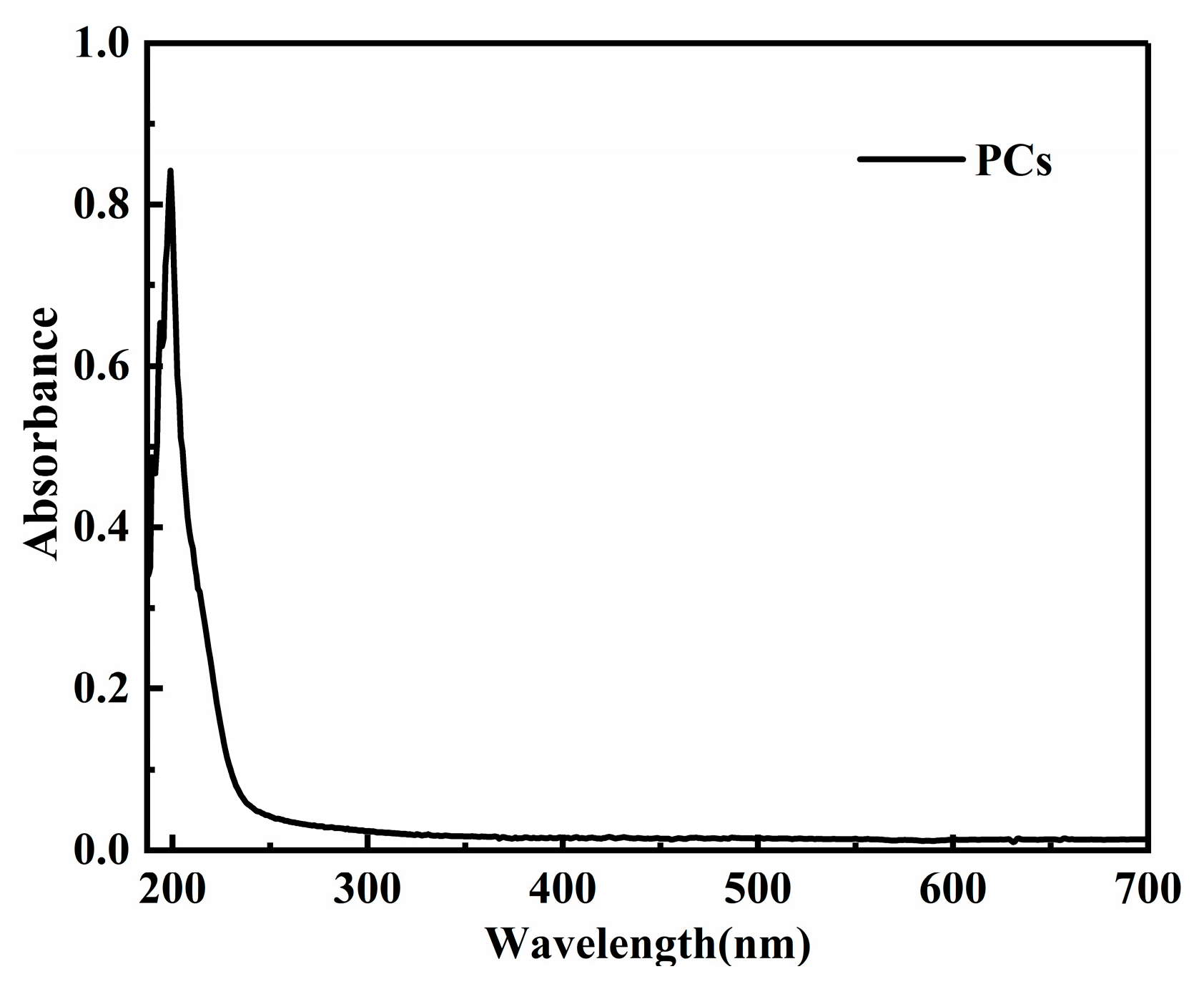
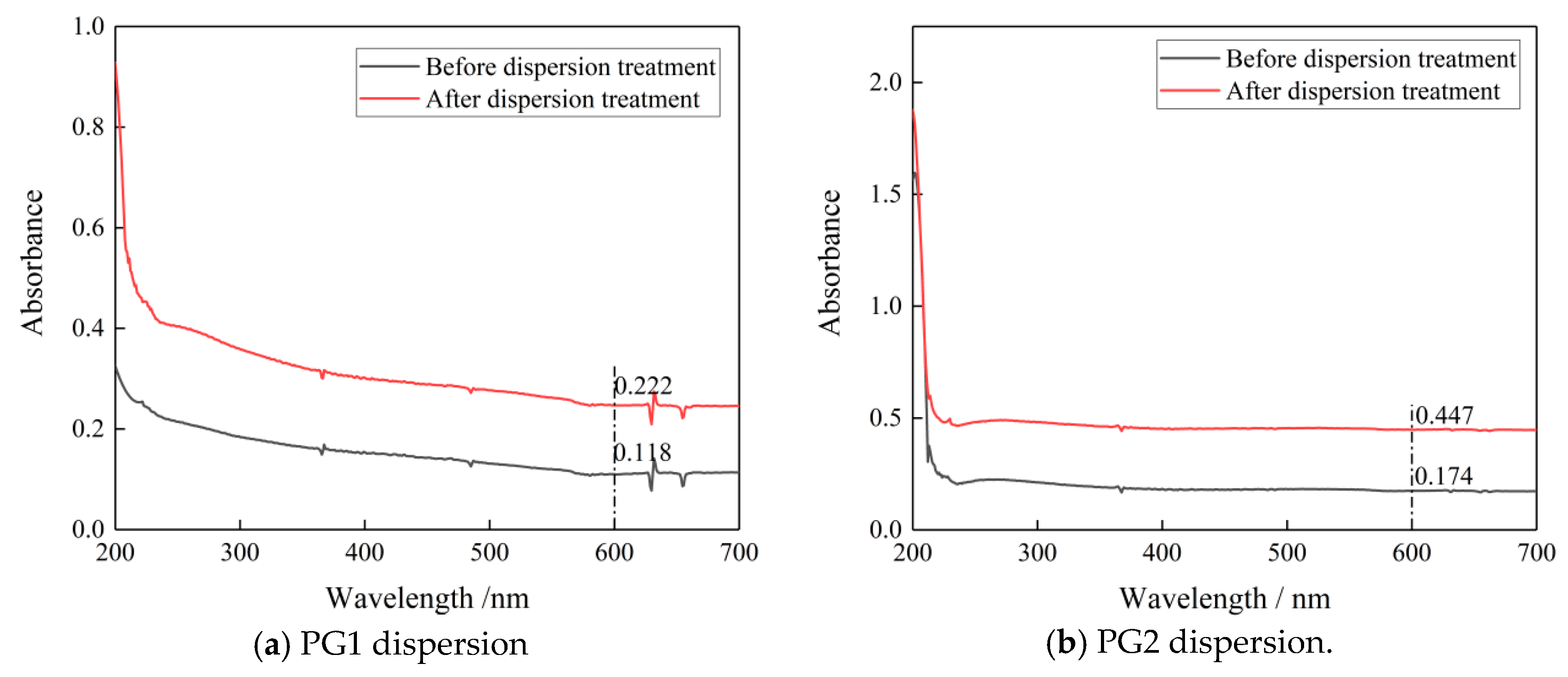
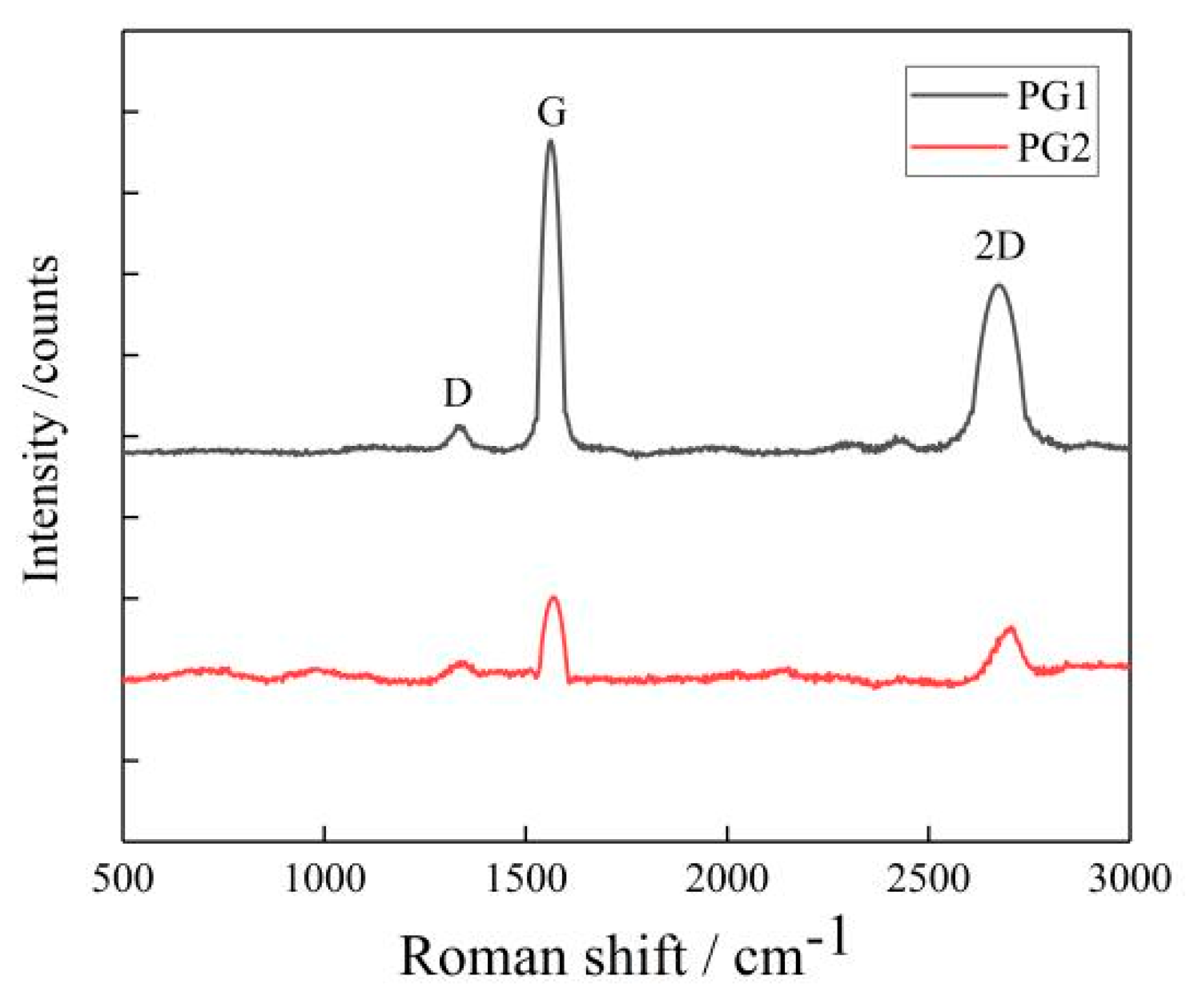
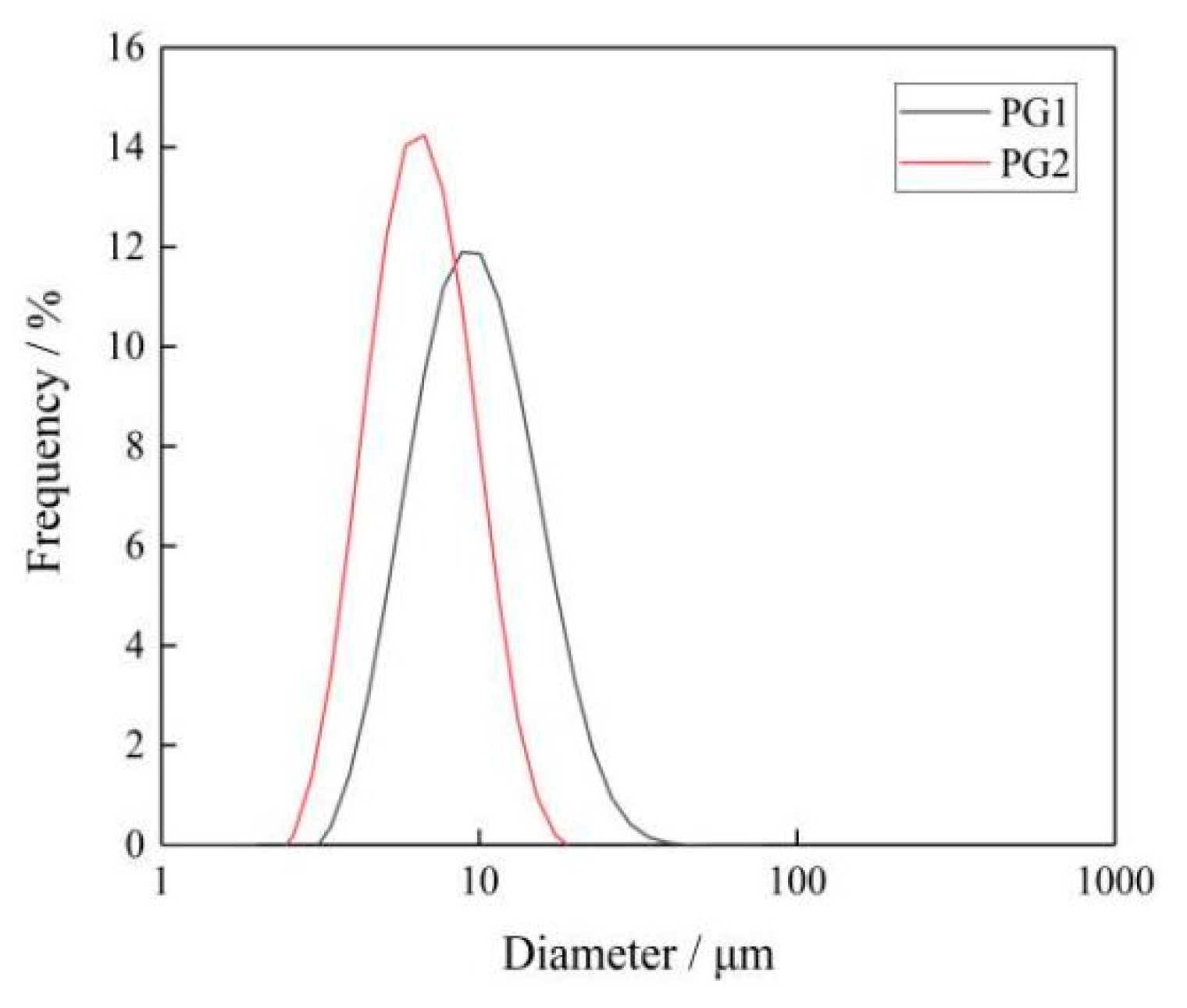
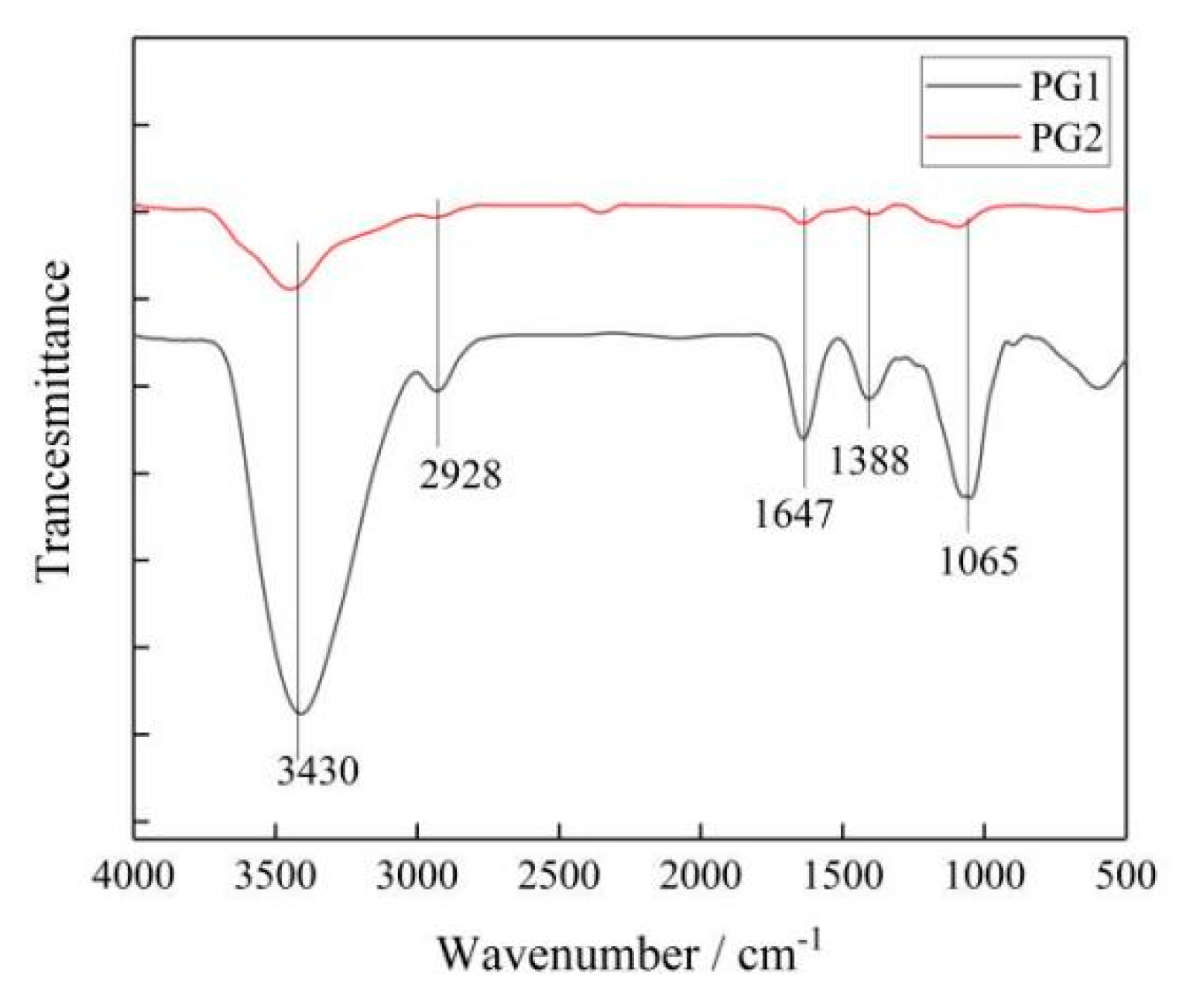
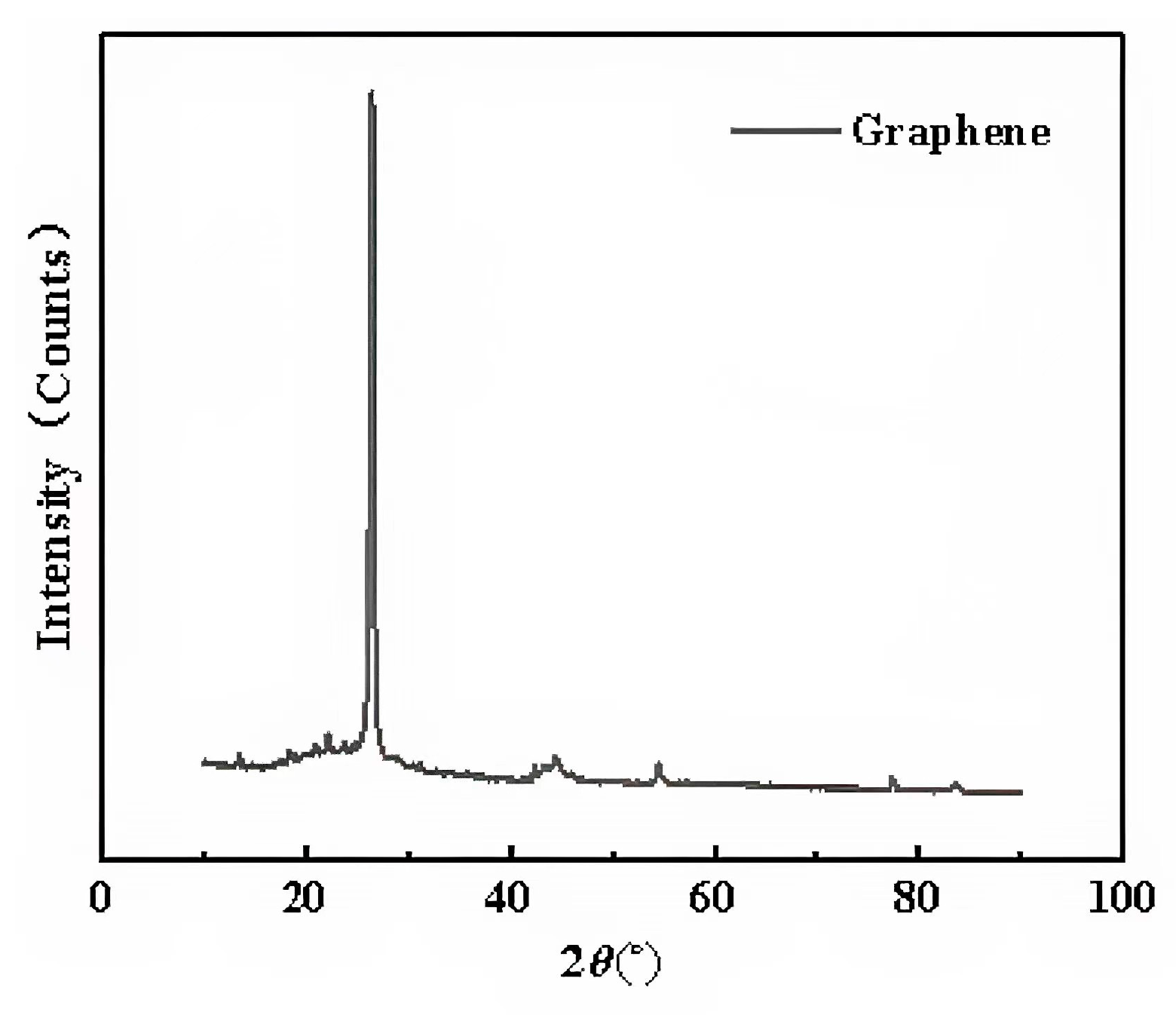
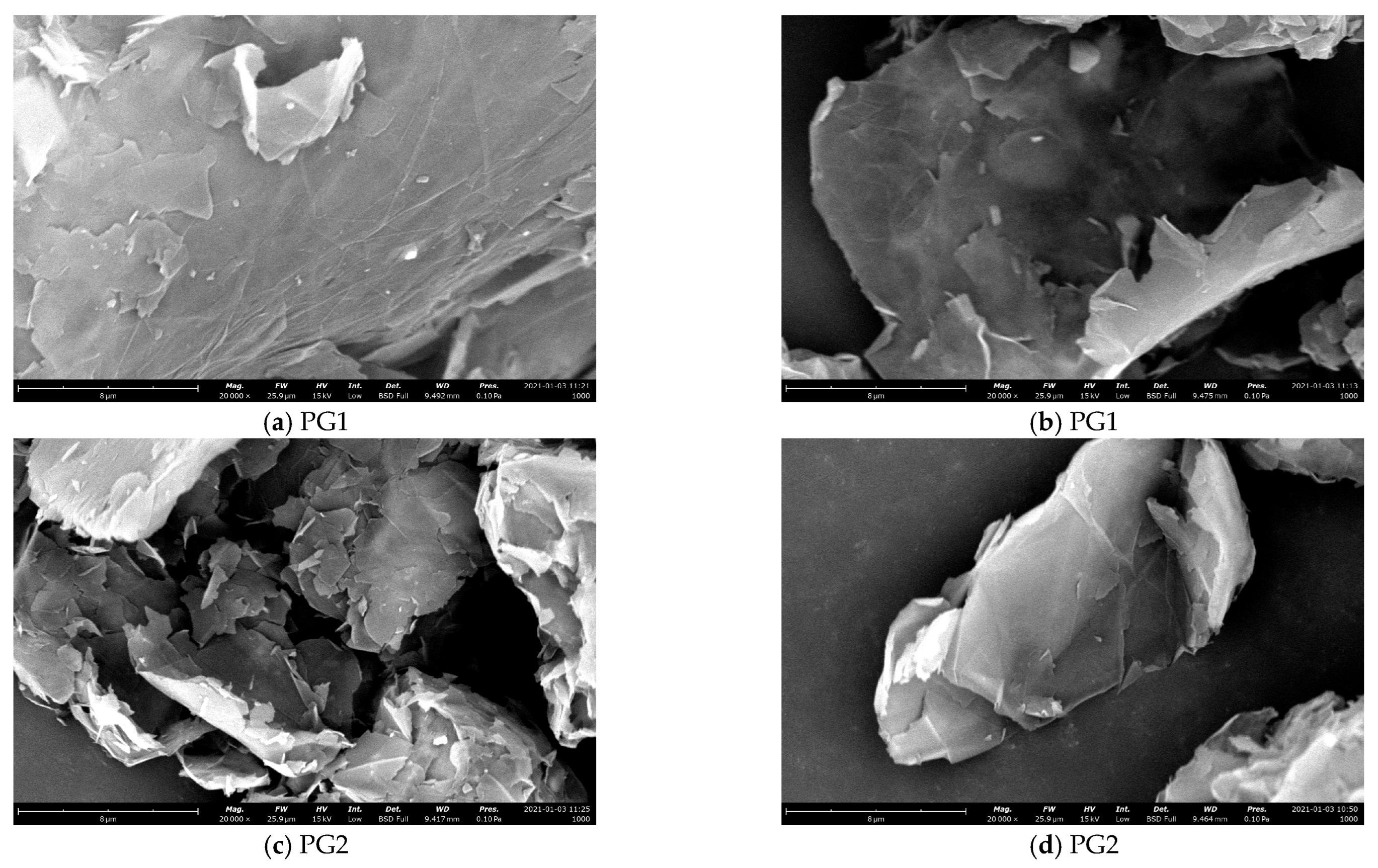
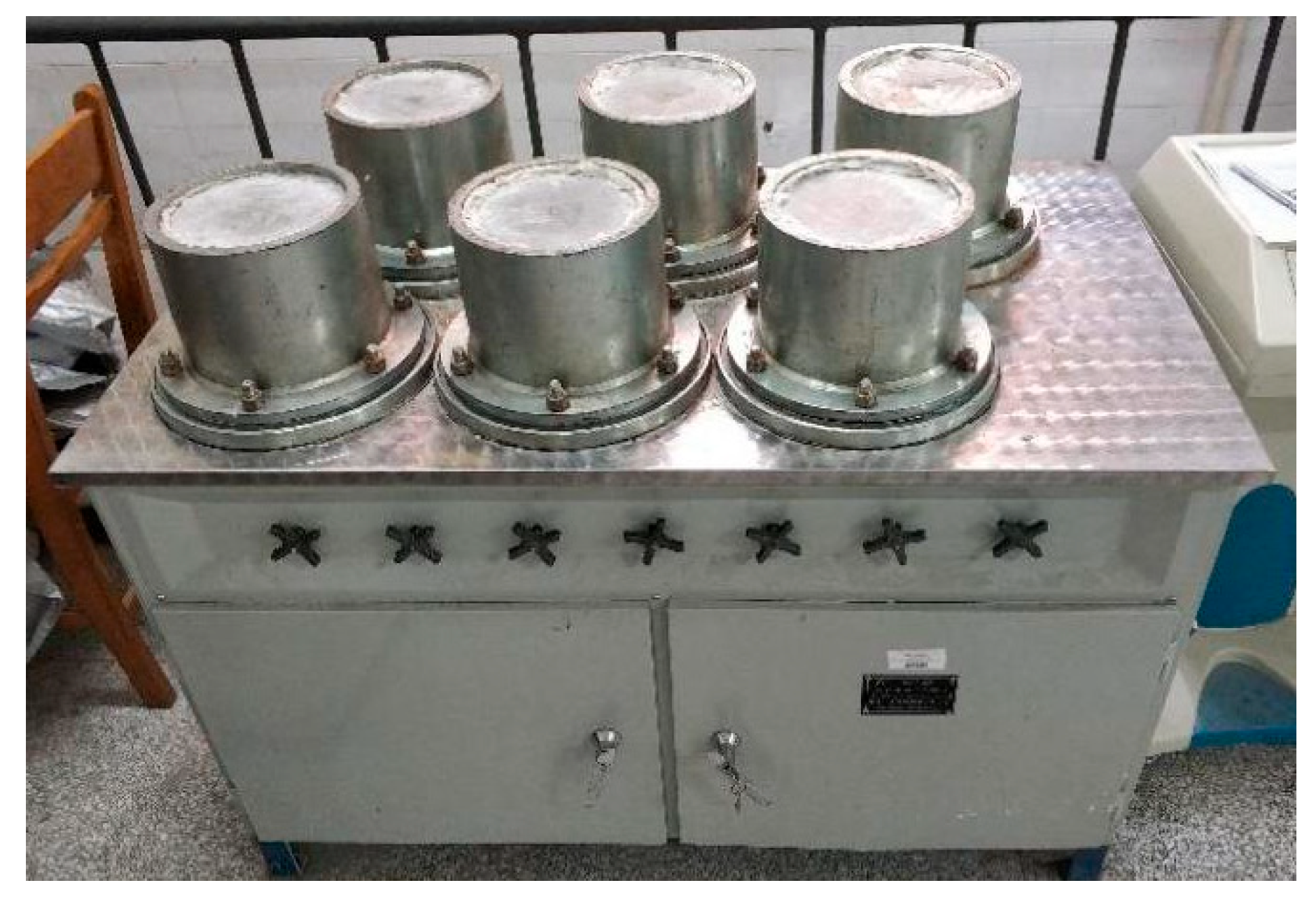
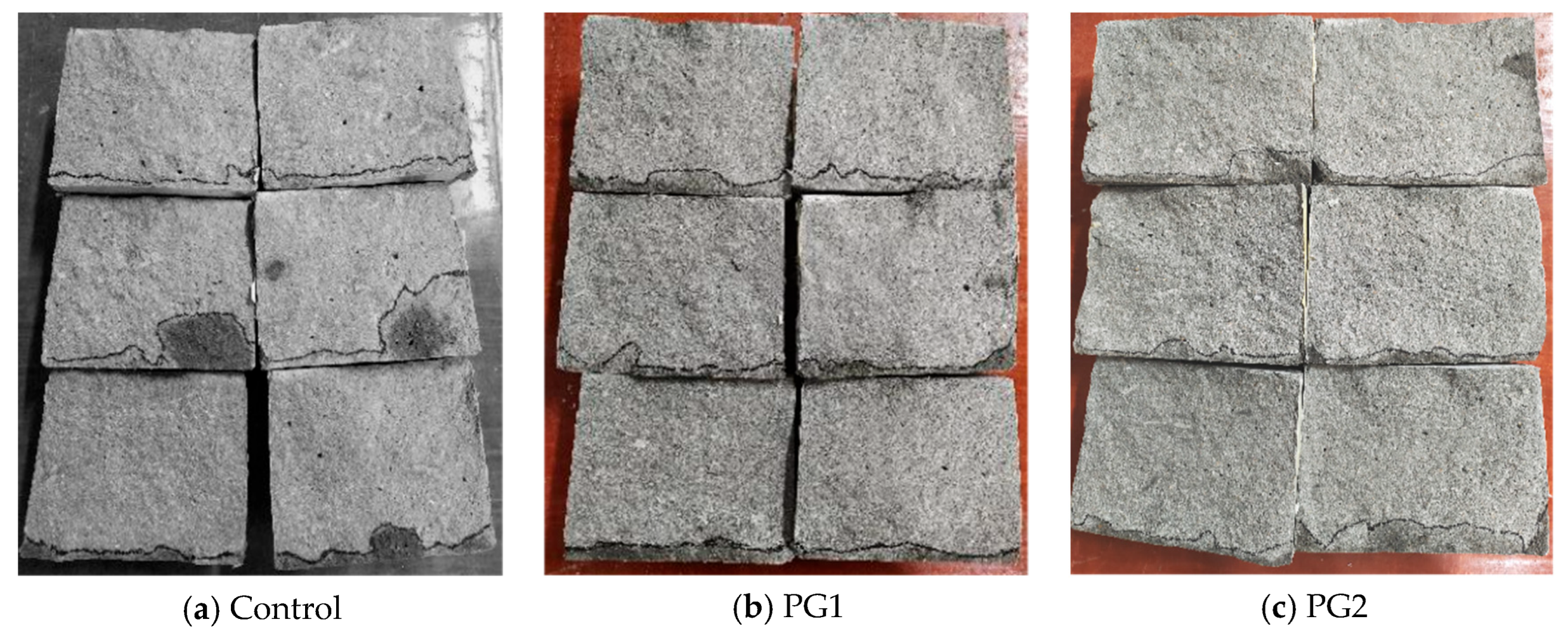


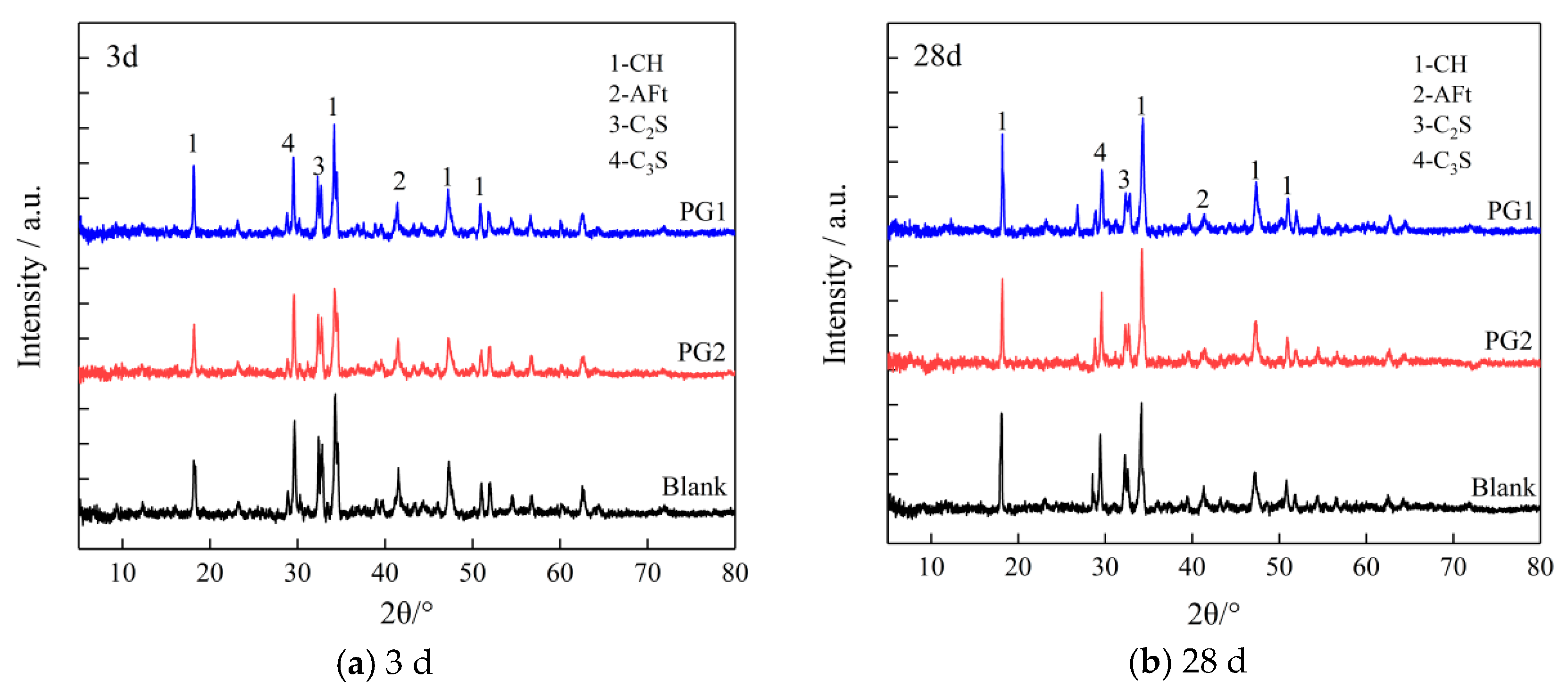
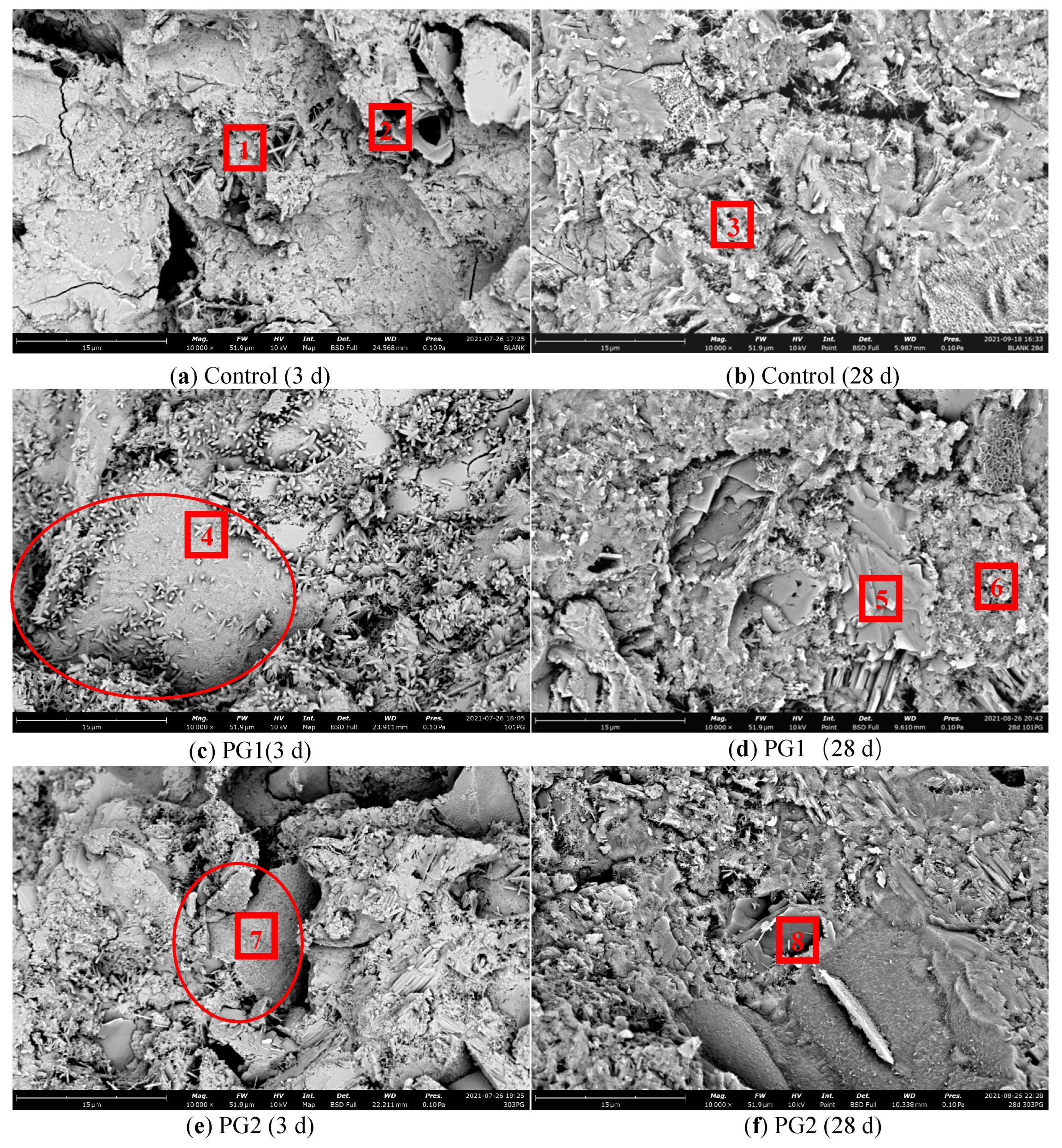


| Product Identity | Water Demand for Normal Consistency/% | Apparent Density/(kg/m3) | Compressive Strength/MPa | Flexural Strength/MPa | Setting Time/min | |||
|---|---|---|---|---|---|---|---|---|
| 3 d | 28 d | 3 d | 28 d | Initial Setting | Final Setting | |||
| P.O 42.5 | 27.8 | 3100 | ≥17 | ≥42.5 | ≥3.5 | ≥6.5 | ≥45 | ≤600 |
| Types of GO | C | O | K | Si | Others |
|---|---|---|---|---|---|
| PG1 | 80.6 | 13.4 | 1.5 | 2.9 | 1.6 |
| PG2 | 82.3 | 11.7 | 0.9 | 2.8 | 2.3 |
| Code | PG1/g | PG2/g | Average Water Permeability Height of Each Group/mm | Average Total Water Permeability Height/mm |
|---|---|---|---|---|
| W0-1 | 0 | 0 | 14.1 | 16.7 |
| W0-2 | 17.8 | |||
| W0-3 | 18.3 | |||
| W1-1 | 0.67 | 0 | 7.0 | 9.0 |
| W1-2 | 10.4 | |||
| W1-3 | 9.6 | |||
| W2-1 | 0 | 0.67 | 12.6 | 13.0 |
| W2-2 | 16.4 | |||
| W2-3 | 10.1 |
| Code | PG1/% | PG2/% | Absolute Value of Voltage/V | Average of Initial and End Temperatures/°C | Samples’ Thickness/mm | Test Duration/h | Average Chloride Permeability Depth/mm |
|---|---|---|---|---|---|---|---|
| C0-1 | 0 | 0 | 20 | 25.5 | 50.1 | 24 | 6.1 |
| C0-2 | 15 | 25.3 | 50.2 | 24 | 6.9 | ||
| C0-3 | 15 | 25.6 | 50.2 | 24 | 7.0 | ||
| C1-1 | 0.02 | 0 | 15 | 29.6 | 49.8 | 24 | 5.9 |
| C1-2 | 20 | 29.3 | 51.0 | 24 | 6.0 | ||
| C1-3 | 20 | 29.0 | 51.1 | 24 | 5.9 | ||
| C2-1 | 0 | 0.02 | 15 | 29.2 | 51.2 | 24 | 5.9 |
| C2-2 | 20 | 29.1 | 50.6 | 24 | 7.1 | ||
| C2-3 | 20 | 29.1 | 51 | 24 | 6.6 |
| Point | C | O | Ca | Al | Si | S | Mg | K | Fe |
|---|---|---|---|---|---|---|---|---|---|
| 1 | 1.56 | 26.48 | 50.31 | 2.65 | 6.82 | 3.51 | 0.61 | 2.43 | 1.82 |
| 2 | 1.43 | 42.18 | 42.21 | 1.65 | 10.80 | 0.56 | 0.54 | 0.51 | 1.12 |
| 3 | 1.02 | 50.48 | 35.98 | 1.14 | 7.33 | 1.23 | 0.45 | 1.01 | 0.14 |
| 4 | 16.56 | 52.33 | 21.85 | 0.79 | 1.43 | 1.11 | 0.51 | 2.85 | 0.42 |
| 5 | 1.39 | 50.03 | 37.67 | 1.56 | 2.37 | 1.42 | 0.26 | 1.46 | 0.57 |
| 6 | 1.27 | 55.32 | 21.85 | 3.62 | 11.26 | 1.25 | 0.13 | 2.85 | 0.33 |
| 7 | 83.24 | 11.49 | 2.90 | 0.03 | 0.92 | 0 | 0 | 0 | 0 |
| 8 | 26.58 | 47.40 | 17.02 | 3.53 | 0.24 | 1.34 | 0.45 | 1.44 | 0.65 |
| Points | C | O | Ca | Al | Si | S | Mg | K | Fe |
|---|---|---|---|---|---|---|---|---|---|
| 9 | 24.55 | 49.32 | 17.50 | 1.25 | 3.25 | 0.73 | 0.29 | 1.82 | 0.42 |
| 10 | 87.84 | 8.75 | 1.26 | 0.42 | 0.27 | - | - | - | - |
| 11 | 12.43 | 43.87 | 30.77 | 1.34 | 2.10 | 1.13 | 0.14 | 0.92 | 0.33 |
| 12 | 90.13 | 6.21 | 0.89 | 0.32 | 0.18 | - | - | - | - |
| 13 | 24.80 | 47.47 | 16.84 | 1.42 | 1.85 | 1.21 | 0.61 | 1.95 | 1.01 |
| 14 | 93.24 | 3.51 | 0.23 | 0.10 | 0.04 | - | - | - | - |
| 15 | 11.11 | 47.55 | 28.93 | 2.36 | 6.42 | 0.17 | 0.79 | 1.02 | 0.97 |
Disclaimer/Publisher’s Note: The statements, opinions and data contained in all publications are solely those of the individual author(s) and contributor(s) and not of MDPI and/or the editor(s). MDPI and/or the editor(s) disclaim responsibility for any injury to people or property resulting from any ideas, methods, instructions or products referred to in the content. |
© 2023 by the authors. Licensee MDPI, Basel, Switzerland. This article is an open access article distributed under the terms and conditions of the Creative Commons Attribution (CC BY) license (https://creativecommons.org/licenses/by/4.0/).
Share and Cite
Dong, J.; Zhuang, J.; Li, W.; Zou, M.; He, Q.; Luo, S. Insights into the Mechanism of Graphene Acting on Water and Chloride Ion Permeability of Cement-Based Materials. Materials 2023, 16, 3881. https://doi.org/10.3390/ma16103881
Dong J, Zhuang J, Li W, Zou M, He Q, Luo S. Insights into the Mechanism of Graphene Acting on Water and Chloride Ion Permeability of Cement-Based Materials. Materials. 2023; 16(10):3881. https://doi.org/10.3390/ma16103881
Chicago/Turabian StyleDong, Jianmiao, Jiaqiao Zhuang, Wanjin Li, Mingxuan Zou, Qi He, and Shuqiong Luo. 2023. "Insights into the Mechanism of Graphene Acting on Water and Chloride Ion Permeability of Cement-Based Materials" Materials 16, no. 10: 3881. https://doi.org/10.3390/ma16103881





